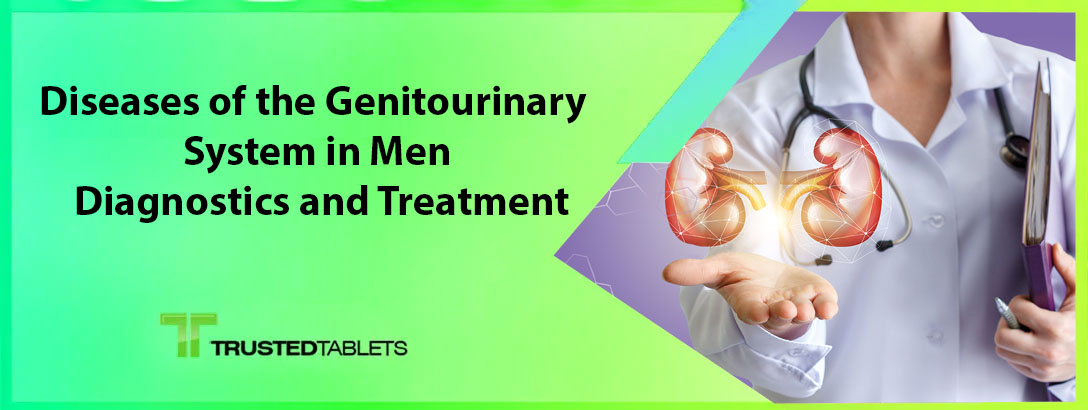Understanding the Genitourinary System
The genitourinary system, which includes the reproductive organs and urinary system, plays a crucial role in male health. Diseases affecting this system can impact various aspects of health and well-being.
What Is the Genitourinary System?
Components:
- Reproductive Organs: Testes, epididymis, vas deferens, seminal vesicles, prostate gland, and penis.
- Urinary System: Kidneys, ureters, bladder, and urethra.
Functions:
- Reproductive: Produces and transports sperm, facilitates sexual function.
- Urinary: Filters blood to produce urine, regulates fluid and electrolyte balance, and removes waste.
Common Diseases of the Genitourinary System in Men
Several diseases can affect the genitourinary system in men, each with distinct symptoms and diagnostic approaches.
1. Prostate Disorders
Benign Prostatic Hyperplasia (BPH):
- Definition: Non-cancerous enlargement of the prostate gland.
- Symptoms: Frequent urination, difficulty starting urination, weak urine stream.
Prostate Cancer:
- Definition: Malignant tumor in the prostate gland.
- Symptoms: Similar to BPH, but may also include blood in urine or semen, painful urination.
Prostatitis:
- Definition: Inflammation of the prostate gland.
- Symptoms: Pain in the pelvic area, painful urination, flu-like symptoms.
2. Urinary Tract Infections (UTIs)
Definition: Infections that can occur in any part of the urinary system. Symptoms:
- Common Symptoms: Burning sensation during urination, frequent urge to urinate, cloudy or strong-smelling urine.
- Severe Symptoms: Fever, chills, back pain.
3. Erectile Dysfunction (ED)
Definition: Inability to achieve or maintain an erection sufficient for sexual activity. Symptoms:
- Difficulty Achieving Erection: Persistent issues with getting or maintaining an erection.
- Impact on Sexual Life: Reduced sexual satisfaction or performance.
4. Testicular Disorders
Testicular Cancer:
- Definition: Malignant growth in one or both testicles.
- Symptoms: Lumps in the testicle, pain or discomfort, swelling.
Epididymitis:
- Definition: Inflammation of the epididymis.
- Symptoms: Pain and swelling in the scrotum, redness, and tenderness.
Orchitis:
- Definition: Inflammation of one or both testicles.
- Symptoms: Swelling, pain, fever.
Diagnostic Approaches
Diagnosing diseases of the genitourinary system involves a combination of medical history, physical examinations, and various diagnostic tests.
Medical History and Physical Examination
Medical History:
- Patient Symptoms: Detailed description of symptoms, including onset and duration.
- Lifestyle Factors: Review of lifestyle factors such as sexual activity, exercise, and diet.
Physical Examination:
- Pelvic Examination: For prostate and testicular disorders.
- Abdominal Examination: To assess for any abnormalities in the urinary system.
Diagnostic Tests
Prostate-Specific Antigen (PSA) Test:
- Purpose: Measures levels of PSA in the blood to help diagnose prostate disorders.
- Use: Elevated levels can indicate BPH, prostatitis, or prostate cancer.
Ultrasound:
- Purpose: Provides imaging of the prostate, testicles, and other parts of the genitourinary system.
- Use: Helps detect abnormalities such as tumors or enlarged organs.
Urinalysis:
- Purpose: Analyzes urine for signs of infection, blood, or other abnormalities.
- Use: Useful for diagnosing UTIs and assessing kidney function.
Cystoscopy:
- Purpose: Allows direct visualization of the bladder and urethra using a scope.
- Use: Diagnoses issues within the bladder or urethra, such as tumors or obstructions.
Treatment Options
Treatment for genitourinary diseases varies based on the specific condition and its severity.
1. Prostate Disorders
Benign Prostatic Hyperplasia (BPH):
- Medications: Alpha-blockers or 5-alpha-reductase inhibitors to reduce symptoms.
- Surgical Options: Transurethral resection of the prostate (TURP) for severe cases.
Prostate Cancer:
- Treatment Options: Includes surgery (prostatectomy), radiation therapy, hormone therapy, and chemotherapy.
Prostatitis:
- Medications: Antibiotics for bacterial prostatitis, anti-inflammatory medications for chronic prostatitis.
2. Urinary Tract Infections (UTIs)
Antibiotics:
- Purpose: Treat bacterial infections causing the UTI.
- Use: Prescribed based on the type of bacteria identified in the urine.
Pain Relief:
- Medications: Analgesics or anti-inflammatory drugs to relieve discomfort.
3. Erectile Dysfunction (ED)
Medications:
- Phosphodiesterase Type 5 Inhibitors: Such as Viagra (sildenafil), Cialis (tadalafil), and Levitra (vardenafil).
Therapies:
- Counseling: For psychological factors affecting ED.
- Vacuum Devices: To help achieve and maintain an erection.
Surgical Options:
- Penile Implants: In cases where other treatments are ineffective.
4. Testicular Disorders
Testicular Cancer:
- Surgery: Orchiectomy to remove the affected testicle.
- Adjuvant Therapy: Depending on the stage, chemotherapy or radiation may be required.
Epididymitis and Orchitis:
- Antibiotics: For bacterial infections.
- Pain Relief: Nonsteroidal anti-inflammatory drugs (NSAIDs) to manage pain and swelling.
Table Summarizing Information
| Disease | Symptoms | Diagnostic Tests | Treatment Options |
|---|---|---|---|
| Prostate Disorders | Difficulty urinating, pelvic pain, blood in urine/semen. | PSA test, ultrasound, biopsy | Medications, surgery, radiation therapy |
| Urinary Tract Infections | Burning sensation, frequent urination, cloudy urine. | Urinalysis, urine culture | Antibiotics, pain relief |
| Erectile Dysfunction | Difficulty achieving/maintaining an erection. | Physical examination, history | Medications, counseling, vacuum devices, surgical options |
| Testicular Disorders | Lumps in testicles, pain, swelling. | Ultrasound, physical examination | Surgery, chemotherapy, antibiotics |
FAQ
What are the common symptoms of prostate disorders?
Common symptoms include difficulty urinating, pelvic pain, frequent urination, and blood in urine or semen.
How are urinary tract infections diagnosed?
UTIs are diagnosed through urinalysis and urine culture to identify the presence of bacteria and determine the appropriate treatment.
What treatment options are available for erectile dysfunction?
Treatment options include oral medications (like Viagra), vacuum devices, counseling, and, in some cases, penile implants.
How is testicular cancer treated?
Treatment for testicular cancer typically involves surgery to remove the affected testicle, with additional treatments like chemotherapy or radiation depending on the cancer’s stage.
What tests are used to diagnose prostate disorders?
Diagnostic tests include the PSA test, ultrasound, and sometimes a biopsy to determine the presence and extent of prostate disorders.
Can urinary tract infections be prevented?
UTIs can be prevented by maintaining good hygiene, staying hydrated, and urinating regularly. For recurrent UTIs, lifestyle changes or preventive medications may be recommended.
What are the signs of epididymitis?
Signs of epididymitis include pain and swelling in the scrotum, redness, and tenderness. It is often treated with antibiotics and pain relief medications.


